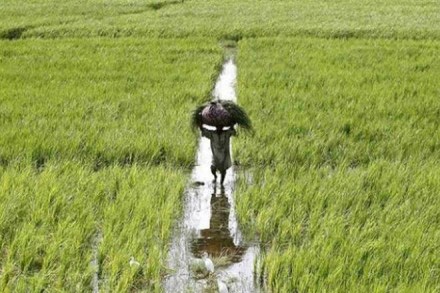By Ashok Gulati & Sandip Das
If there is one thing that bewilders the reader in the agri-food space of the Union Budget for FY21, it is a massive reduction in food subsidy. The Revised Estimate (RE) of food subsidy for FY20 has been slashed by a whopping Rs 75,552 crore, from the Budgeted Estimate (BE) of Rs 184,220 crore to only Rs 108,668 crores. And, the BE for FY21 has been kept at Rs 115,570 crore. One wonders if any major reforms have been undertaken in the grain management system or the National Food Security Act such that this massive reduction in allocation is feasible.
Alas, it is only a sleight of hand by our experts in the finance ministry. The Food Corporation of India (FCI) has been asked to borrow more and more from myriad sources, but, most importantly, from the National Small Savings Fund. An item that should be in the budget is now getting reflected in increasing amounts of outstanding dues of FCI.
The accompanying graphic gives the implications of this. For gauging how much the effective food subsidy in the country is, the budgetary numbers are becoming totally irrelevant. One needs to add the actual subsidy reflected in the budget to the outstanding dues of FCI. If one does that, the effective food subsidy turns out to be Rs 357,688 crore. By not provisioning it fully in the Budget, and by not undertaking any reforms in the foodgrain management system, or NFSA, the Centre is only postponing the crisis for the next government.
Now, look at the grain situation in the country as on January 1 every year. Compared to a buffer stock norm of 21.4 million tonnes, the actual stocks with FCI (including unmilled paddy) were 3.5 times more. It speaks of colossal waste of scarce resources, especially when tax revenues have been sluggish.
Given that Skymet has predicted that the coming wheat crop is going to be one of the best in many years, likely to touch 113 million tonnes, and procurement prices being above global prices, the chances of exports of wheat are bleak unless there is subsidy for exports. And, that will be challenged in WTO. So, one should expect piling up of grains stocks, with record procurement of wheat—FCI may run out of storage capacity. The stock levels may touch 85-90 million tonnes, or even more, by July 1, 2020.
This raises some fundamental questions. One, is the government ignorant of the impending crisis of plenty in grains? Second, does it realise that the policy of procurement prices (50% above cost A2+FL) without looking into the demand side is likely to create more troubles for the government? Third, does government has any plan to reforms the public distribution system under NFSA? The Budget gives no indication of any reforms in the grain management system in the near future. In the absence of that, one wonders what the government’s game plan is.
Foodgrain management reforms have to start with reforming the PDS system, gradually moving away from grains to cash transfers. And, policy of procurement prices, with open-ended procurement in the Punjab-Haryana belt, is doing more damage, by depleting the water table, and not letting crop diversification take place. This is very unfortunate as the “dead loss” in grain management runs up to more than Rs 100,000 crore. This does not reflect well on the government’s policymaking. The government’s attitude appears to be that of an ostrich, with its head in the sand—nay grain!
Interestingly, during Modi 1.0, the first High Powered Committee to reform the grain management system was set up under former Union food minister Shanta Kumar. The report is on FCI’s website—all that is needed is the courage to bite the bullet. The Economic Survey talks of moving in the direction of cash transfers, but the government seems to have developed cold feet, and public money is being wasted year after year, running into thousands of crores. Nothing can be more ironical than this, especially when the government is scratching its head desperately to raise revenue.
The other part related to this grain abundance is the fertiliser subsidy, which is largely used in wheat and rice. The BE for FY21 shows a reduction, while the pending dues of the fertiliser industry keep piling up. The fertiliser industry estimates that by April 2020, the pending dues will amount roughly to Rs 60,000 crore. While FCI has been asked to borrow, the fertiliser industry does not have that type of window; it is feeling totally demoralised. No private entity wants to invest in this sector. No wonder, all the new plants coming up are in the public sector—this will be another major problem in the years to come. And, this is happening when the Budget speaks of Zero Budget Natural Farming. One wonders whether the left hand of the government realises what the right one is doing?
